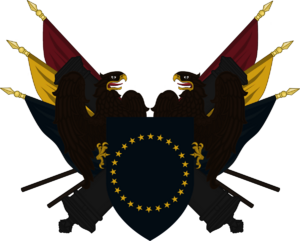Constitution of Carloso
This article is incomplete because it is pending further input from participants, or it is a work-in-progress by one author. Please comment on this article's talk page to share your input, comments and questions. Note: To contribute to this article, you may need to seek help from the author(s) of this page. |
| Constitution of Carloso | |
|---|---|
 | |
| Jurisdiction | |
| Date effective | 20 June 1956 |
| System | Constitutional parliamentary republic with an executive council, chaired by a president |
| Chambers | Unicameral |
| Executive | President |
| Federalism | Federation |
The Constitution of the Federal Republic of Carloso (Carlosian: TBD) is the supreme law of Carloso.
The Constitution created a system of representative democracy in Carloso, inherited from the previous constitution, but established Carloso for the first time as a federation of administrative provinces rather then a unitary state. While generally categorised as a federal republic, Carloso under the 1956 constitution is often referred to as a 'quasi-federal' or a 'unitary state with a federal spirit', due to the limited powers delegated to the provinces and the supremacy of the central government.
Background
History
Influences
Main provisions
Current text
Preamable
Article I
1. Legislative power will be vested in the National Assembly. Members of the National Assembly will be referred to as National Assemblymen and elected every five years on 11 November, taking office on 11 February of the following year Candidates seeking the office of National Assemblyman must be natural-born citizens of Carloso, resident in the country, and have attained the age of thirty years by or on the day of election. National Assemblymen will be elected from three-member constituencies by means of the single transferable vote. Should a National Assemblyman vacate their seat, a by-election will by held within five calendar months to fill that vacancy, unless in the insistence where the vacancy occurs within one annual year of the next general election.